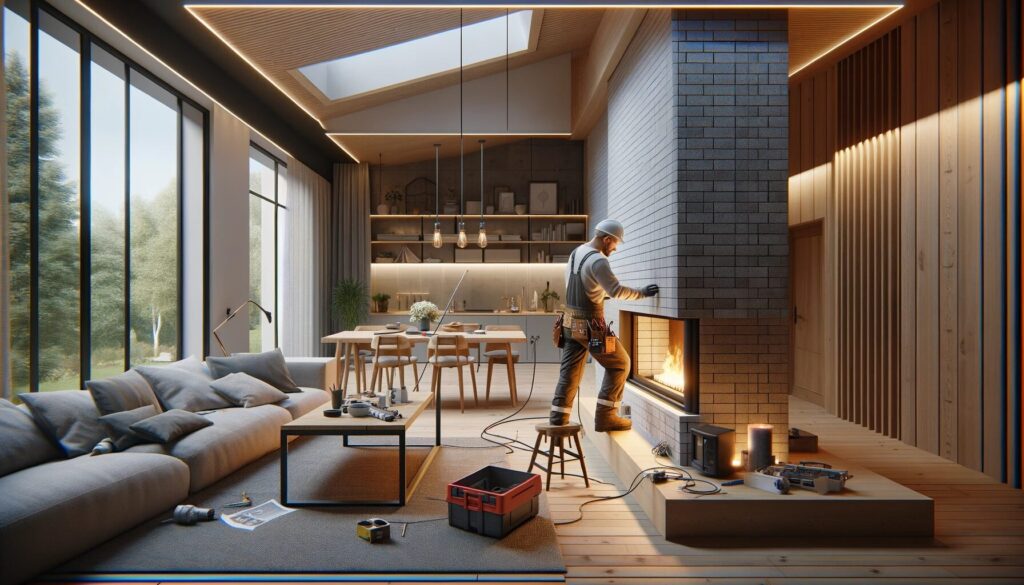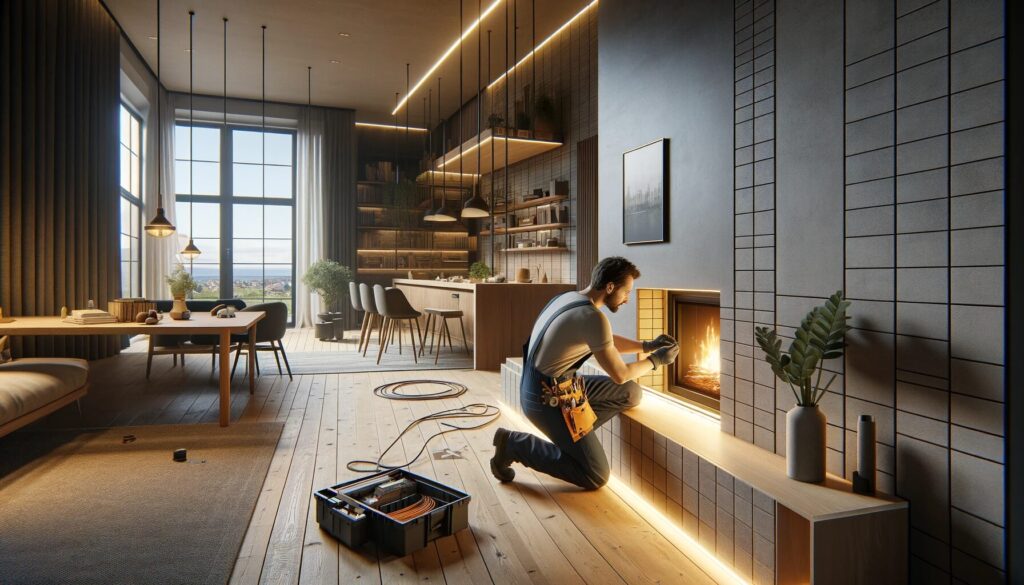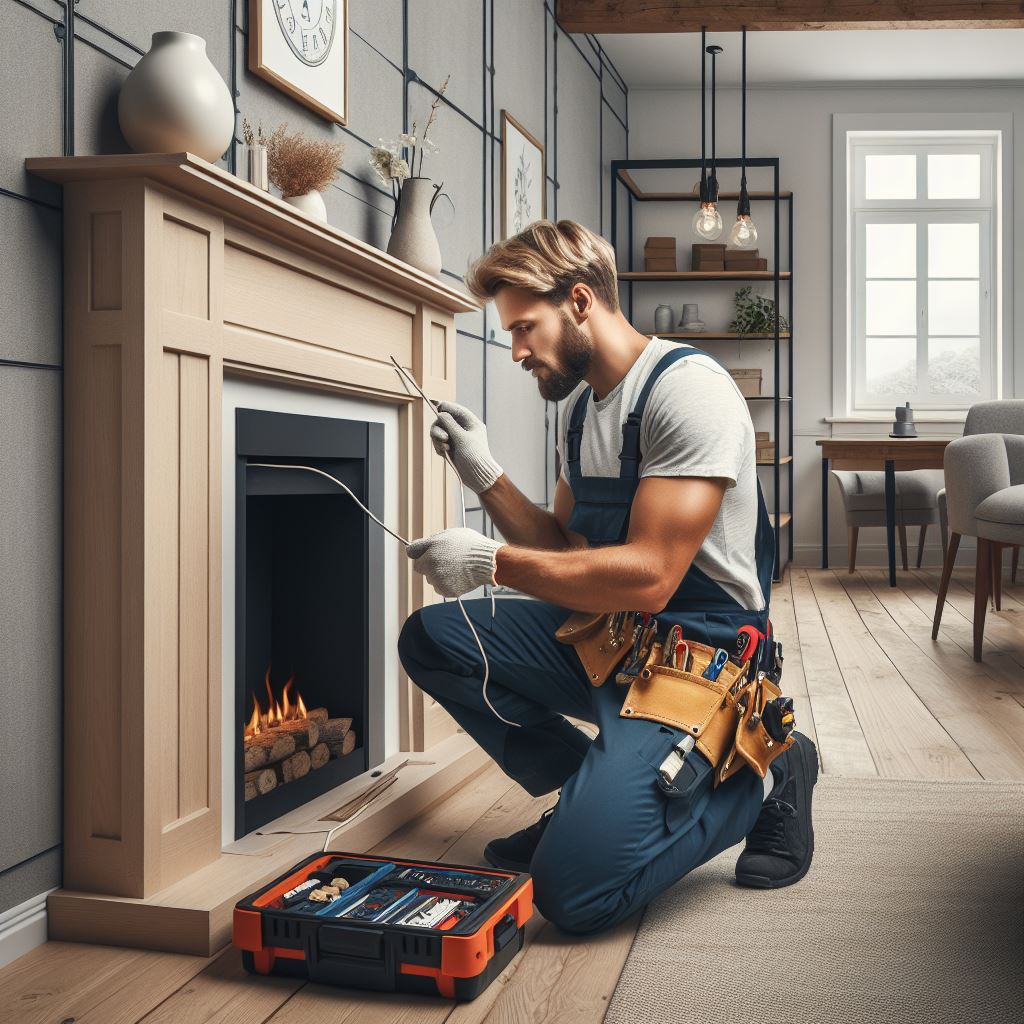Embarking on the journey of fireplace refacing is a transformative step in any home renovation. This isn’t merely about aesthetics, it’s a functional upgrade that enhances both the appearance and value of your home. For those of you who are hands-on DIY enthusiasts or skilled handymen, this project is an opportunity to showcase craftsmanship and inject a personal touch into your living space. Refacing your fireplace can redefine the ambiance of your room, making it a cozy, inviting focal point.

Understanding Fireplace Refacing
Fireplace refacing is essentially a makeover for your fireplace, but it’s more than just a surface-level change. It involves either a cosmetic update, like changing tiles or panels, or a comprehensive overhaul, which includes replacing the entire facing of the fireplace. Cosmetic updates are relatively straightforward – akin to giving your fireplace a new coat of paint. However, a full-scale refacing is akin to reconstructing the fireplace’s exterior, offering a chance to completely revitalize its style and function.
Preparing for Your Fireplace Refacing Project
- Safety Gear: Prioritize safety with gloves, goggles, and dust masks.
- Demolition Tools: Equip yourself with a sledgehammer, pry bar, and chisel for removing the old facade.
- Installation Tools: Prepare a notched trowel, mortar, grout, and tile cutter for the new installation.
- Finishing Tools: Have a caulking gun, grout float, and level on hand for the final touches.
Safety Precautions: Safety cannot be overstated. Ensure your workspace is clear and always wear protective gear. Dealing with heavy materials and sharp tools can be hazardous, so precautions are vital.
Assessing Your Fireplace: Before starting, thoroughly evaluate your fireplace. Look beyond the surface for any structural or functional issues, like problems with the flue or the fireplace’s foundation. A careful assessment at this stage can prevent future complications, ensuring a smooth and successful refacing process.

Choosing the Right Materials
When it comes to selecting materials for refacing your fireplace, think of it as choosing the perfect outfit for a long-anticipated event. The materials you choose should not only complement the style of your home but also stand the test of time.
- Stone: Opting for stone brings an element of nature into your home. Its durability is unparalleled, but keep in mind, its heavy weight demands a sturdy foundation and precise installation. While it might be a costlier option, the end result is a timeless and robust facade.
- Tile: Tiles are a versatile choice, offering a wide range of colors and designs. They’re lighter and easier to maneuver than stone, making installation a bit more DIY-friendly. However, their susceptibility to cracks means handling them with care is paramount.
- Brick: For those seeking a traditional look, brick is a steadfast choice. It’s not only durable but also relatively easier to work with compared to stone. Although it may limit you if you’re aiming for a modern aesthetic, its classic charm is undeniable.
- Veneer: Veneers are a practical alternative to natural stone or brick. They offer a similar look but are lighter and easier to install. The trade-off, however, is in their durability, which doesn’t quite measure up to their natural counterparts.
When selecting materials, it’s crucial to consider the overall architecture and interior design of your home. A mismatched fireplace can disrupt the harmony of your living space.
Step-by-Step Guide to Refacing a Fireplace
- Removing the Old Facade: Approach this step with caution and patience. Use tools like a hammer, chisel, or crowbar to gently remove the existing material. Be mindful not to damage the underlying structure, as this forms the base for your new facade.
- Preparing the Surface: A clean, smooth surface is key. Any leftover debris or unevenness can hinder the installation of the new materials. Ensure the surface is ready to provide a solid foundation for the new facade.
- Applying the New Material: This is where your chosen material comes into play.
- For stone or brick, apply mortar uniformly and place each piece carefully. It’s crucial to keep the surface level to avoid a lopsided finish.
- When using tiles, spread adhesive evenly and place tiles with precision, using spacers for consistency. After setting the tiles, apply grout to fill in the gaps and seal the surface.
- For veneers, the process mirrors that of tiles. Apply adhesive, place the veneer pieces carefully, and ensure they adhere well to the surface.
- Customizing for Different Fireplaces: Tailor your approach based on the type of fireplace. A raised hearth requires careful consideration of material transition, while a brick surround might call for a contrasting material to create a focal point.

Addressing Common Challenges
In my years of renovating, I’ve encountered just about every hiccup you can imagine in fireplace refacing. Let me share some wisdom:
- Dealing with Uneven Surfaces: In an ideal world, every surface would be perfectly level. In reality, we often face the challenge of uneven surfaces. My go-to solution is using a self-leveling compound for minor irregularities. For more pronounced issues, carefully chisel away the high points. Remember, a smooth, level surface is crucial for a flawless finish.
- Ensuring the New Facade is Securely Attached: To avoid a facade that shifts or falls, proper attachment is key. For heavier materials like stone, I recommend a fortified thin-set mortar, applied evenly. For lighter materials like tiles or veneers, a high-quality construction adhesive should suffice. Patience is important here – allow ample time for the adhesive to cure before proceeding.
- Working Around Existing Mantels or Features: Many homes feature mantels or architectural details that need to be preserved during refacing. It’s essential to protect these elements by covering them securely. If a mantel needs to be removed, do so gently and store it in a safe place until reinstallation. Work carefully around these features to ensure they’re not damaged during the refacing process.
Finishing Touches
As with any project, the finishing touches can make all the difference:
- Adding Decorative Elements: This is where personal style comes into play. Consider adding decorative trim or molding for a traditional look, or opt for sleek, straight lines for a more contemporary feel. The key is to complement the overall design of your home.
- Sealing and Protecting the New Surface: Properly sealing your new fireplace facade will protect it from stains and moisture, prolonging its beauty and functionality. Use a penetrating sealer for stone or brick, and ensure grout is well sealed in tiled surfaces.
- Cleaning and Maintenance Tips for the New Facade: Regular maintenance will keep your fireplace looking its best. For tiles and veneers, a simple wipe with a damp cloth suffices. For natural stone or brick, use gentle, non-abrasive cleaners to avoid damaging the surface.
FAQ Section
This depends on the complexity of the project and your skill level. Tiling or applying veneers can be a manageable DIY project. However, heavier materials like stone, or structural modifications, may require professional expertise.
Generally, it can take from a weekend to a week, depending on the scope and complexity of the project. Thorough preparation can streamline the process, but it’s important not to rush.
Not always. If the existing surface is stable and even, you can apply new materials directly over it. However, if there are signs of damage or significant unevenness, it’s best to start with a clean slate.
Opt for materials that can withstand high temperatures, such as natural stone, brick, or heat-resistant tiles. Ensure that the materials are rated for fireplace use.
Select materials and designs that harmonize with your home’s existing aesthetic. Consider the colors, textures, and styles present in your space to create a cohesive look.
For a raised hearth, ensure a seamless transition between the hearth and the face of the fireplace. Consider the proportions and materials to maintain balance and symmetry.
